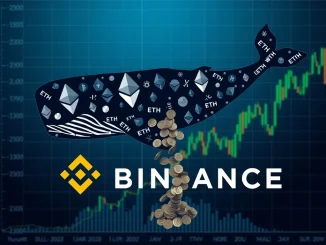
A significant signal from the traditional finance world is turning heads in the crypto space. Fidelity Digital Assets, a major player in institutional crypto investment, has released a report suggesting that **Ethereum (ETH)**, the second-largest cryptocurrency, might currently be undervalued. This isn’t just speculation; their analysis is based on specific data points that often precede market shifts.
Decoding the **Fidelity Report**: Why ETH Might Be Undervalued
Fidelity’s latest deep dive into the Ethereum network uses several key **On-Chain Metrics** to gauge market sentiment and potential value. These metrics provide insights into the fundamental activity and economics happening directly on the blockchain, rather than just relying on price charts.
The report specifically highlights metrics such as:
- **MVRV Z-Score:** This metric compares the market value of Ethereum to its realized value (the average price at which coins were last moved). A low MVRV Z-Score often suggests the market is trading below the ‘fair value’ based on average acquisition costs, potentially indicating undervaluation or capitulation.
- **NUPL Ratio (Net Unrealized Profit/Loss):** This metric shows the overall state of unrealized profit or loss across the network. Negative NUPL values can signal that a significant portion of the market is holding ETH at a loss, a condition often seen during capitulation phases when assets might be considered **Crypto Market Undervalued**.
According to Fidelity, these metrics are showing signs consistent with historical periods of market capitulation for Ethereum.
Contrasting Signals: Recent **ETH Price Analysis** vs. Network Growth
It might seem counterintuitive to hear about potential undervaluation, especially after the recent price performance. The **Fidelity Report** notes that Ethereum experienced a significant price drop, around 45%, during Q1 2025. This kind of price movement typically suggests weakness, not value.
However, the report points to a crucial counter-trend: the surge in activity on Ethereum’s layer-2 networks. Despite the price decline, layer-2 solutions saw a record 13.6 million active addresses. This indicates that while the spot price faced pressure, actual user adoption and network utility continued to grow robustly. This divergence between price action and fundamental network use is a key reason behind Fidelity’s suggestion of potential undervaluation.
What Do These **On-Chain Metrics** Really Tell Us?
On-chain metrics offer a unique perspective compared to traditional financial analysis. They measure the actual behavior of network participants.
For example:
- A low MVRV Z-Score can imply that long-term holders who acquired ETH at higher prices are now at a loss, and intense selling pressure might be subsiding as only those willing to hold through difficult times remain.
- A negative NUPL reinforces this idea, showing widespread unrealized losses which can be a precursor to a market bottom if selling pressure from those unwilling to realize losses dries up.
When combined with increasing network activity (like the layer-2 address growth), these metrics paint a picture of a network with growing fundamental use but a price that hasn’t yet reflected that growth, leading to the argument that **Ethereum (ETH)** could be trading below its intrinsic value based on network health.
The **Fidelity Report**’s Cautious Optimism
While the report highlights signals of potential undervaluation, Fidelity Digital Assets maintains a stance of cautious optimism. They acknowledge the positive indicators from on-chain data and layer-2 growth, suggesting a foundation for potential recovery.
However, they also include a crucial warning based on historical **ETH Price Analysis**. Past market cycles show that even when these capitulation-like signals appear, further price declines are still possible before a sustained recovery takes hold. This emphasizes that market bottoms are processes, not single points, and volatility can persist.
Implications for the **Crypto Market Undervalued** Narrative
Fidelity’s report adds weight to the argument that certain crypto assets, specifically Ethereum in this case, might be undervalued based on fundamental network activity and historical market cycle patterns. It shifts the focus from short-term price swings to the underlying health and adoption of the network.
For investors and market watchers, this means paying attention to more than just the daily price chart. Monitoring key **On-Chain Metrics** and network growth indicators, as highlighted in the **Fidelity Report**, can provide valuable context for understanding potential long-term value, even during periods of price weakness.
Conclusion: Is **Ethereum (ETH)** Poised for a Turnaround?
The recent **Fidelity Report** offers a compelling data-driven perspective on Ethereum’s current state. By analyzing key **On-Chain Metrics**, Fidelity suggests that despite a challenging Q1 2025 price performance, fundamental network health, particularly on layer-2s, remains strong, potentially signaling that the asset is **Crypto Market Undervalued**. While cautious optimism prevails and further volatility is possible, the report provides a solid basis for considering the long-term value proposition of **Ethereum (ETH)** based on its underlying utility and adoption trends.



